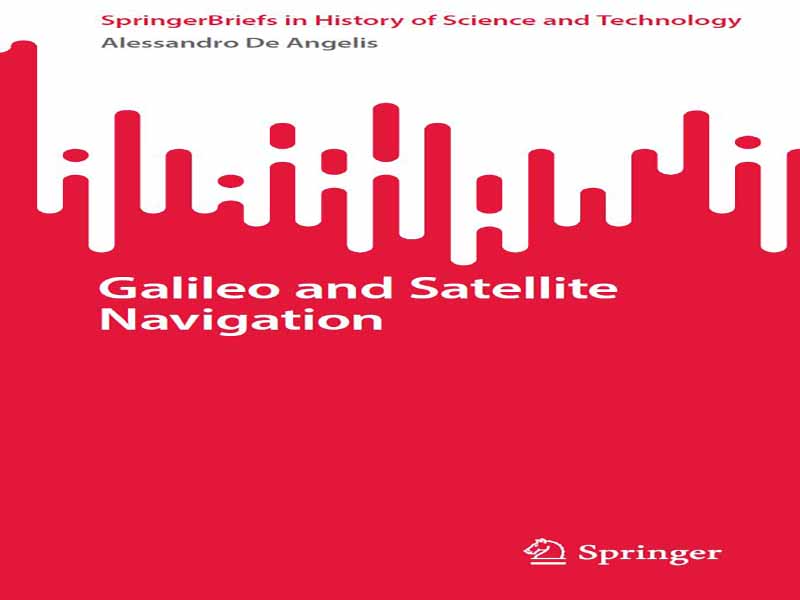- عنوان کتاب: Galileo and Satellite Navigation
- نویسنده: Alessandro De Angelis
- حوزه: ماهواره
- سال انتشار: 2024
- تعداد صفحه: 79
- زبان اصلی: انگلیسی
- نوع فایل: pdf
- حجم فایل: 2.99 مگابایت
گالیله اندکی پس از کشف قمرهای مشتری، متوجه شد که موقعیتهای متقابل آنها، ساعتی مطلق را فراهم میکند که میتوان از زمین به آن رجوع کرد و کاربردهای احتمالی این ساعت به وسواسی تبدیل شد که تا زمان مرگش او را درگیر خود کرد. یک دریانورد در دریاهای آزاد میتوانست زمان محلی کسوف یکی از قمرهای مشتری را یادداشت کند (به طور متوسط، هر شب دو یا سه کسوف وجود دارد) و آن را با زمانی که انتظار میرفت در نقطه مرجع اروپایی رخ دهد، مقایسه کند. این اختلاف، طول جغرافیایی کشتی را به دست میداد که در ترکیب با یک تکنیک شناخته شده برای محاسبه عرض جغرافیایی، امکان موقعیتیابی جغرافیایی را فراهم میکرد. در سال ۱۶۱۲، دیپلماسی فلورانس مذاکراتی را با پادشاهی اسپانیا آغاز کرد تا جداول (که از آنها ابزاری نیز مشتق شده بود) اختراع گالیله را برای محاسبه کسوف قمرهای مشتری و تلسکوپهایی برای انجام مشاهدات در اختیار دریانوردان ایبری قرار دهد. شش سال طول کشید تا اسپانیاییها این ایده را ارزیابی کنند و به این نتیجه رسیدند که انجام مشاهده از عرشه کشتی در دریاهای آزاد به دلیل غلتش و شیب غیرممکن است. گالیله پس از محکومیتش (که در سال ۱۶۳۳ رخ داد) دوباره به این مسئله پرداخت و این بار از طریق واسطهها با فرمانداری کل هلند مذاکره کرد. در حالی که گالیله (تا زمان ارزیابی نهایی پروژه) با یک گردنبند طلای ارزشمند پاداش گرفت، که دادگاه تفتیش عقاید او را از پذیرش آن منع کرده بود، کمیته فنی هلند نیز مانند کمیته اسپانیایی در این مورد تردید داشت. ناوبری ماهوارهای که در زمان گالیله به دلیل فاصله قابل توجه و نزدیکی زاویهای نسبی قمرهای مشتری و مشکلات نشانهگیری تلسکوپها از نظر فنی غیرممکن بود، در عصر فضا امکانپذیر شده است. از چهار صورت فلکی ماهوارههای موقعیتیابی جغرافیایی در مدار امروز، صورت فلکی اروپایی به نام خود گالیله نامگذاری شده است. این کتاب داستان پیشنهاد گالیله برای موقعیتیابی جغرافیایی را روایت میکند و آن را از نظر تاریخی و نجومی بین «قبل» (تکنیکهای منسوب به یونانیان و تکمیل شده توسط ستارهشناسان قرون وسطی) و «بعد» (ورود ساعتهای دقیق به صحنه؛ سپس، در قرن بیستم، انتقال بیسیم سیگنالهای الکترومغناطیسی؛ و در نهایت، فناوری فضایی) قاببندی میکند. این کتاب عمدتاً بر اساس بیست جلد از نسخه ملی زیبای آثار گالیله است که بین سالهای ۱۸۹۰ تا ۱۹۰۹ توسط آنتونیو فاوارو منتشر شده است. با توجه به سنت رایج در میان گالیلهپژوهان، از این پس به این کتاب صرفاً با عنوان «آثار» اشاره خواهم کرد. همچنین از جلد چهارم نسخه بهروز شده «آثار» که توسط میشل کامروتا به همراه پاتریزیا روفو ویرایش شده است، استفاده میکنم. این جلد که در سال ۲۰۱۹ منتشر شد، برخی از اسناد منتشر نشده در مورد تماسهای بین گالیله و دولت اسپانیا برای فروش روش گالیلهای تعیین طول جغرافیایی در دریا را ارائه میدهد. اسناد ذکر شده، نامههای گالیله و موارد مرتبط دیگر در متن کتاب، عمدتاً از «آثار» گرفته شدهاند. من همیشه به وضوح به نسخه اصلی اشاره میکنم و در صورت امکان، شماره حرف پیشرو در آثار را که قبل از شماره جلد آمده است (مثلاً [11/757]) در داخل کروشه میآورم، در غیر این صورت جلد و صفحه را (مثلاً [A4/p79]، که A4 نشان دهنده جلد چهارم نسخه بهروز شده است) ذکر میکنم. من متون را از ایتالیایی، کاستیلی، لاتین و فرانسوی ترجمه کردهام، اما همیشه با ارجاع واضح به نسخه اصلی. به طور خلاصه، خوانندهای که به ویژه کنجکاو یا علاقهمند به زبانشناسی است، به راحتی منابع لازم را برای ارضای کنجکاوی خود پیدا خواهد کرد. من همچنین، تا حد کمتری، به برخی از متون ذکر شده در کتابشناسی تکیه کردهام. مناسبت نوشتن این کتاب، برگزاری «روز تحقیقات ایتالیایی در جهان» توسط هیئت نمایندگی دائمی ایتالیا در سازمانهای بینالمللی در پاریس در سال 2024 بود: موضوع آن موقعیت جغرافیایی بود. این رویداد که با همکاری موزه گالیله در فلورانس و دانشگاه سوربن پاریس برگزار شد، شامل نمایشگاه «گالیله و ناوبری ماهوارهای» بود که از ۱۳ ژوئن تا ۲۸ ژوئن ۲۰۲۴ در گالری «لا پاسرل» در پردیس پیر و ماری کوری برگزار شد. این نمایشگاه از ۲۱ تا ۳۱ اکتبر در موسسه فرهنگ ایتالیا در پراگ، از ۹ تا ۱۳ دسامبر در موسسه فرهنگ ایتالیا در آمستردام برگزار شد و قرار است دوباره در موسسه فرهنگ ایتالیا در استکهلم و در موسسه پریمیتر در واترلو (کانادا) برگزار شود.
Soon after discovering Jupiter’s satellites, Galileo Galilei realized that their mutual positions provided an absolute clock that could be consulted from Earth, and the possible uses of this clock became an obsession that haunted him until he died. A navigator on the high seas would have been able to note the local time of an eclipse of one of Jupiter’s satellites (on average, there are two or three each night) and compare it with the time it was expected to occur at the European reference point; the difference would provide the ship’s longitude, which, combined with a well-known technique for calculating latitude, would allow geolocation. In 1612, Florentine diplomacy began negotiations with the Spanish Crown to provide Iberian navigators with tables (from which an instrument was also derived) of Galilean invention to calculate eclipses of Jupiter’s satellites and telescopes with which to make observations. It took the Spaniards six years to evaluate the idea, concluding that it was impossible to perform the observation from the deck of a ship on the high seas because of roll and pitch. Galileo took up the problem again after his conviction (which occurred in 1633), this time negotiating through intermediaries with the States General of the Netherlands. While Galileo was rewarded (pending the final evaluation of the project) with a valuable gold necklace, which the Inquisition forbade him to accept, the Dutch technical committee had doubts in line with the Spanish committee. Satellite navigation, technically impossible at the time of Galileo because of Jupiter’s satellites’ considerable distance and relative angular proximity and the difficulties of pointing telescopes, has become feasible in the space age. Of the four constellations of geolocating satellites in orbit today, the European constellation is named after Galileo himself. This book tells the story of the Galilean proposal for geolocation, framing it historically and astronomically between the “before” (the techniques attributed to the Greeks and perfected by medieval astronomers) and the “after” (the arrival on the scene of precision clocks; then, in the twentieth century, the wireless transmission of electromagnetic signals; and finally, space technology). The book is based primarily on the twenty volumes of the beautiful National Edition of the Works of Galileo, published between 1890 and 1909 by Antonio Favaro. Keeping with a widespread tradition among Galileo scholars, I will refer hereafter to this book simply as the Works. I also make use of the fourth volume of the updated edition of the Works, edited by Michele Camerota together with Patrizia Ruffo; this volume, published in 2019, presents some unpublished documents on the contacts between Galileo and the Spanish government for the sale of the Galilean method of determining longitude at sea. The documents cited, Galileo’s letters, and those otherwise relevant in the context of the book are mostly taken from the Works. I always make a clear reference to the original edition, giving in square brackets, where possible, the progressive letter number in the Works, preceded by the volume number (e.g., [11/757]), otherwise the volume and page (e.g., [A4/p79], where A4 indicates the fourth volume of the Update). I have translated the texts from Italian, Castilian, Latin, and French, but always with a clear reference to the original. In short, the reader who is particularly curious or interested in philology will easily find the necessary references to satisfy his curiosity. I have also relied, to a lesser extent, on some of the texts listed in the bibliography. The occasion for writing this book was the organization by the Italian Permanent Delegation to the International Organizations in Paris of the 2024 “Italian Research Day in the World”: the subject was geolocation. The event, organized in collaboration with the Museo Galileo in Firenze and Sorbonne Université Paris, comprised the exhibition “Galileo and satellite navigation” held at the “La Passerelle” gallery in the Pierre et Marie Curie Campus from June 13 to June 28, 2024. The exhibition was replicated in the Italian Institute of Culture in Prague from October 21 to 31, in the Italian Institute of Culture in Amsterdam from December 9 to 13, and is going to be replicated again in the Italian Institute of Culture in Stockholm, and at the Perimeter Institute in Waterloo (Canada).
این کتاب را میتوانید از لینک زیر بصورت رایگان دانلود کنید:
Download: Galileo and Satellite Navigation



































نظرات کاربران